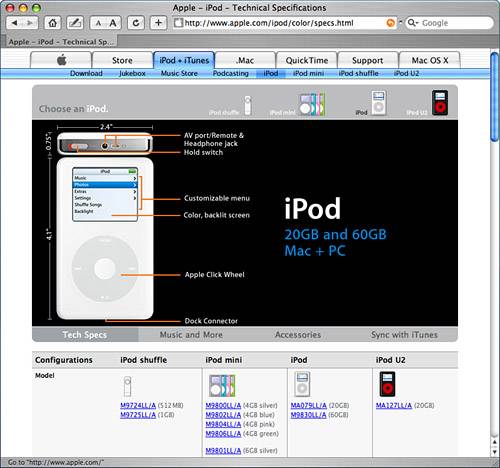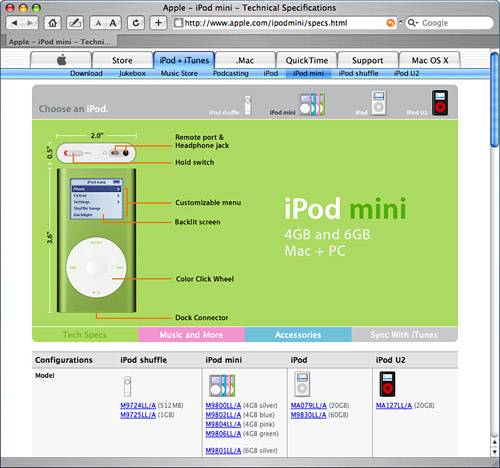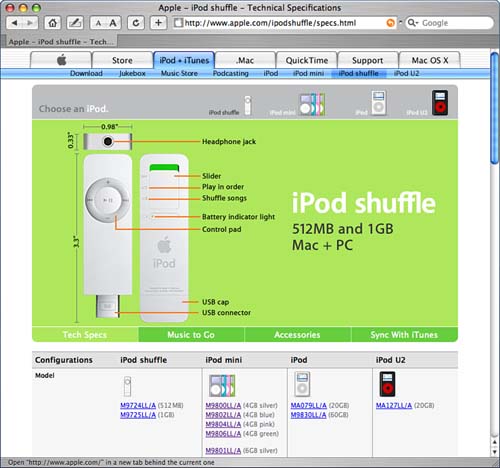All iPod Models Aren t Equal, But They Are All Cool
All iPod Models Aren't Equal, But They Are All CooliPods come in four basic models: iPod, iPod U2, iPod mini, and iPod shuffle. All these models are definitely cool, and all perform the same basic function, which is to enable you to listen to music whenever and wherever. However, each offers specific features and options, as you will see in the following sections. Before we get into the details of each model, let me warn you that just like the times, the iPod is a changin'. The models listed and described in this chapter are the ones available at press time. Apple regularly makes changes to existing models and introduces new models. The good news is that, even if you use a model that isn't specifically described in this chapter, the information in this book will still help you because in many ways, to know one iPod is to know them all. The controls and options might vary a bit, but most functionality is quite similar, regardless of model. note
The iPodThe iPod is the "standard" iPod, although that word seems to imply that it is less than it really is (see Figure 1.1). The iPod offers many great features in a cool package that you will be proud to carry with you anywhere you go. In addition to your music, you can use an iPod to store your digital images and then display them on its screen or on a TV through its AV port. Because it's designed for more data, this model offers the largest hard drives. Figure 1.1. The iPod will definitely rock your world. note
At press time, the iPod's specifications were the following:
The iPod miniThe iPod mini is smaller than an iPod (which you can probably guess from its name). Its other major characteristic is that it comes in a variety of colors (see Figure 1.2). Figure 1.2. With an iPod mini, you can listen to music and make a fashion statement at the same time. At press time, the iPod's mini offered the following:
The iPod shuffleOf all the iPod models and variants, the iPod shuffle is the "most" in many ways (see Figure 1.3). It is the most different from the technical point of view because it does not have a hard drive but instead uses a flash drive to store your music. The benefit to this is that it has no moving parts and will never skip, along with being even more resistant to damage. This also means it uses much less power and so can play the same amount of time with a smaller battery. The downside is that it can store much less music than any of the other models. The shuffle is the most "small" model and is less than half the size of even the iPod mini. The flipside to this is that the shuffle has no screen so you can't see information about the music you are playing or even select what you want to hear. The shuffle also uses the most different interface with your computer in that you plug it directly into a USB port. Finally, the shuffle is the most cost-efficient model. Figure 1.3. The iPod shuffle looks quite different from the other iPod models because it is very different from them. The following is the skinny on this skinniest of iPod models:
Which iPod Is Right for You?If you already have an iPod and don't envision buying another one, you can skip to the next section. Otherwise, read on for some general guidance on choosing an iPod model. note
One of the most frequent questions I get asked is, "Which iPod should I buy?" Unfortunately for me, this is also one of the hardest questions I get asked. That's because each model offers features and benefits that the others don't. And, of course, each costs a different price. There is never a clear-cut answer to this question, unless you can afford to spend only $99, in which case your only choice is the 512MB iPod shuffle (which isn't a bad choice, by the way). Like all electronic devices, choosing an iPod is a matter of balancing features and options against cost. While I can't address your individual choice, I can provide some general guidance because each model does offer some distinct benefits. If you have a digital camera and often find yourself running out of room for your photos on its memory card, an iPod can be a perfect companion for you. With an adapter, you can move photos from the camera onto the iPod and then erase your camera's card so you can take more pictures. Later, you can move the photos from the iPod onto your computer. Plus, you can view your pictures on the iPod and display them on a TV. And, the iPod offers larger disk drives, which benefits both music and photo storage. The only downside to the iPod is its price, although the 20GB model is only $50 more than the 6GB iPod mini and you get 14GB of additional disk space plus the color screen. The 60GB iPod is only $100 more than the 20GB model; you'll find that additional 40GB of space useful if you have lots of music and photos. If the iPod's color is important to you or if you want a smaller iPod without the significant storage limitations of the shuffle, the iPod mini is your choice. The color and smaller size do come with a price, though. After a time, you'll probably find the 4GB or 6GB drive size to be a bit limiting unless you don't have a very large music collection. For $100 more than the 4GB mini or $50 more than the 6GB mini, you can get an iPod that offers 14GB more room plus a larger screen. If you are going to be using an iPod under "extreme" conditions, such as during heavy exercise, sporting activities, or work situations, an iPod shuffle is a good choice because this model is much more resistant to damage than the other models and, with its lower cost, you are risking less by using it in these situations. Plus, it is very small so carrying it is definitely the easiest. So, what is the bottom line? There isn't one. All iPods are a good choice. Some will fit your needs and budget better than others, but you really can't go wrong with any of them. Pick the most you can afford to spend and then get the model that fits your budget and specific needs. note
|
EAN: N/A
Pages: 194